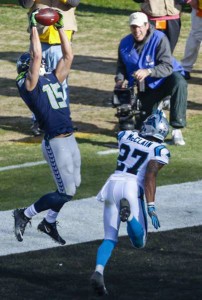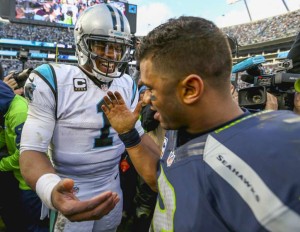
If there ever was a single game that mirrored an NFL team’s season, it would have to be the Seattle Seahawks 31-24 loss to the Carolina Panthers in the Divisional Round of the NFL playoffs a couple of weeks ago. By halftime of that game Seattle trailed 31-0 and just about everything that could have gone wrong for the Hawks, had gone wrong. Most anyone reading this likely saw the game, so you would know what I am talking about—but just in case you have repressed the memories:
- The Panthers received the game’s opening kickoff and started their first possession at their own 25 yard line. On the very first play from scrimmage Carolina running back Jonathan Stewart lined up in the I formation, took the handoff from Cam Newton, picked his way through the right side of the Seahawks defensive line (the Panthers left) and broke free for 59 yards all the way to the Seattle 16. Though the play was well blocked by the Panthers, if you go back and watch it again you will see that the terrible turf at Bank of America stadium, which had just been re-sodded several weeks earlier, played a distinct role in aiding Stewart’s run. Even with the good blocking, the play should have netted no more than 8 yards. As Stewart is weaving his way into the 2nd level of Seattle’s defense you will see Earl Thomas flying up from his safety position to Stewart’s left and make a break towards the running back, only to have his feet slip on the loose turf—and down goes Thomas. To Stewart’s right the same thing happens to Hawks linebacker Bobby Wagner, and what should have been an 8-10 yard gain becomes 59.
- On the very next play, from the Seattle 16 yard line, Newton handed the ball to Panthers running back Cameron Artis-Payne who tried to take it straight up the middle of the Hawks defense, only to encounter Seattle’s Michael Bennett, who stripped the ball from Artis-Payne’s grasp. The ball hit the turf and then was either kicked or bounced forward right into the waiting arms of Panthers fullback Mike Tolbert. A play that should have been a disaster for Carolina, robbing them of a scoring opportunity, wound up being a 7 yard gain. Two plays later the Panthers scored the game’s first touchdown to take a 7-0 lead.
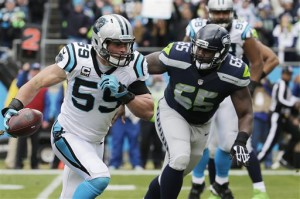
Carolina linebacker Luke Kuechly returning his interception of a Russell Wilson pass for a TD
- After the ensuing kickoff, and after Marshawn Lynch had been stuffed for a 3 yard loss on Seattle’s first play from scrimmage, the Hawks had a 2nd and 13 situation at their own 11 yard line. On that play quarterback Russell Wilson took the snap from under center and was immediately forced into a hurried roll to his right by pressure from Panthers All Pro defensive lineman Kawann Short, who had absolutely abused Seahawks left guard Justin Britt and was on Wilson almost instantaneously. It was then that Russell made what was likely Seattle’s mistake of the game. He should have just taken the sack. Sure it would have given the Hawks a 3rd and long deep in their own territory, but that would have been infinitely better than what did happen. With Short grabbing him from behind Wilson tried to get off a short pass in the direction of Marshawn Lynch about 5 yards beyond the line of scrimmage. Whether because Lynch hadn’t played in two months, or the pressure of the moment, the two Seahawks simply were not on the same page. Wilson threw the ball to the outside just as Lynch turned inside, which resulted in the pass going right to Panthers linebacker Luke Kuechly; who simply plucked it from the air, broke to his right and sauntered into the end zone for the Panthers 2nd touchdown. The game wasn’t even 4 minutes old and Seattle already trailed 14-0.
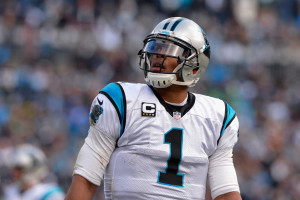
From there the Seahawks finally got something going on their next possession and, using a 22 yard completion from Russell Wilson to tight end Luke Willson, took the ball into Panthers territory. The drive stalled when Wilson was again sacked by Kawann Short, who this time devastated Seattle left tackle Russell Okung and threw the Seattle QB for a 10 yard loss. Truth told Wilson should have thrown the ball away because he had the time to do that; but he didn’t, opting instead to try and make a play. The result was a 3rd and long the Hawks couldn’t convert. Following the punt the Panthers put together a sustained, 15 play, 86 yard drive to a touchdown which give them a 21-0 cushion. The drive was the longest in terms of time Carolina had manufactured all season, wiping out nearly the last 9 minutes of the 1st quarter and the first minute of the 2nd. It was after receiving the subsequent kickoff that Wilson and Seattle made their next crushing mistake:
- The ensuing kickoff gave the Seahawks a 1st and 10 at their own 20 yard line. On the very first play of the possession Seattle lined up in an empty backfield with Russell Wilson in the shotgun. On the snap of the ball Wilson looked to his left, where Luke Willson was running a short crossing route and Jermaine Kearse a deeper, square out route. Kearse was definitely open, but as Wilson tried to get him the ball he was hit from the left side by Carolina defensive lineman Mario Addison, who had gotten around Seattle’s Russell Okung, in the process dislocating Okung’s shoulder. The result was that the pass fluttered into a no man’s land between Luke Willson and Kearse where it was easily intercepted by Panthers cornerback Cortland Finnegan, thus giving Carolina the ball and great field position at Seattle’s 28 yard line. Following the “sudden change”[1], Seattle’s defense held allowing only a field goal, but the Seahawks were now in a 24-0 hole with barely 3 minutes gone in the 2nd quarter.
Seattle couldn’t do anything on their next possession and had to punt, once again giving Carolina excellent field position to start their next drive. From their own 44 yard line Cam Newton and company then took 9 plays across 4 minutes and 45 seconds to go up on Seattle 31-0. The touchdown came on a beautiful 19 yard laser strike from Newton to tight end Greg Olsen, who, though tightly covered by Seattle’s Jeremy Lane, made an excellent, diving catch in the end zone.
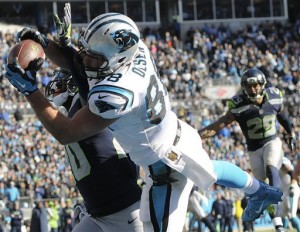
When Olsen scored there were just over 6 minutes left in the 2nd quarter. The first half to that point had been an unmitigated disaster for Seattle. Personally I have never seen a Pete Carroll Seahawks team play so poorly, and I could envision no realistic scenario for them to get back in the game. Marshawn Lynch was back and he seemed to be healthy, but the Seattle running game was nonexistent. The Panthers were dominating the line of scrimmage on both sides of the ball. Over the last 6 minutes of the half Seattle did manage to move the ball deep into Panthers territory as Russell Wilson began to make some plays with his receivers, but Carroll decided to skip the field goal and go for it on 4th and 5. When Wilson’s pass to Doug Baldwin came up short the Panthers took over and the Hawks went into halftime on the short end of a 31-0 score.
As I said at the outset of this article, this game against Carolina was a microcosm of the Seahawks season, and the hole the team dug for themselves in the game’s first half illustrates this—a bit more extreme perhaps, but a good comparison nonetheless. There is a tried and true formula to getting to the Super Bowl and it centers around winning your Division and having the best record in the Conference. Those circumstances guarantee a first round playoff bye and home field playoff games from that point on. It is the formula Seattle used in 2013 and 2014 to get to the Big Game and it is the formula Carolina used this year. Whether because of the flap surrounding Kam Chancellor’s hold out or the unsettled situation with the offensive line; Marshawn Lynch getting injured or Jimmy Graham just not fitting in, or all four, the Seahawks simply did not play well in the first half of the 2015 season. They got off to an 0-2 start, losing road games to the St. Louis Rams and the Green Bay Packers; and after week 10 of the season had a losing, 4-5 record. Making matters worse was a disturbing propensity the Seahawks had developed for blowing games in the 4th quarter; something totally foreign to a team that prides itself on finishing. Seattle had the lead in the 4th quarter in all 5 of their losses and in each instance could not make the lead stand.
Meanwhile the Arizona Cardinals, with quarterback Carson Palmer having the season of his life, were running away with the Division; and the Carolina Panthers were flirting with an undefeated season. By week 10 it was obvious that if the Seahawks were to make a 3rd straight Super Bowl run they would have to do it the hard way as a Wild Card. That meant they would first have to make the playoffs and then would need to win 3 playoff games in a row, and on the road, just to get to the Big Game; a daunting task for any team. With 5 losses already and 7 games remaining Seattle could ill afford another defeat.
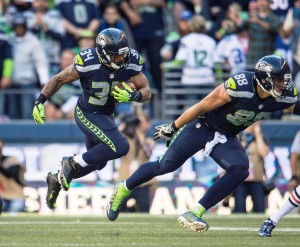
Then things began to turn for the Hawks. They beat the 49ers in week 10 to even their record at 5-5 as rookie running back Thomas Rawls exploded for 209 yards rushing and Russell Wilson threw for 260 yards and 3 TDs. Seattle followed that game with a dramatic Week 11 win over the Pittsburgh Steelers at The Clink; a game in which Wilson threw for 345 yards and an astounding 5 touchdowns, 3 of them to Doug Baldwin, while losing Jimmy Graham for the season when he tore up his knee. Then came a sound thumping, on the road no less, of the NFC Central leading Minnesota Vikings by a score of 38-7. Rawls had another 100 yard rushing game versus the Vikings and Wilson threw for 274 more yards and 3 more TDs, 2 of them to Baldwin. Seattle’s defense, by now completely returned to form, held the All World Vikings running back Adrian Peterson to a paltry 28 yards and the Legion of Boom otherwise completely shut down Minnesota’s offense.
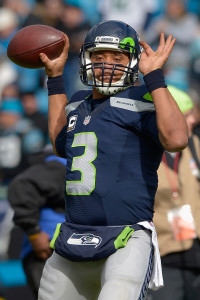
After the Vikings game it was obvious that the Seahawks were back, and in some ways better than ever. With Marshawn Lynch and Jimmy Graham injured, Russell Wilson was elevating his game. Across the above referenced 3 games he threw for nearly 900 yards and 11 touchdowns with no interceptions. An immediate consequence of this was that veteran slot receiver Doug Baldwin was emerging as an elite NFL receiver, something that he always knew he was capable of. With the rookie Rawls[2] toting the rock and rookie wide receiver Tyler Lockett[3], as well as Jermaine Kearse, catching passes, the Seahawks were humming. They put an exclamation point to their streak with two more blowout victories, the first a 35-6 wipeout of the Baltimore Ravens on the road followed by a 30-13 drubbing of Johnny Manziel and the Cleveland Browns at home. Against the Ravens Wilson threw 5 more TDs, and then 3 more against the Browns to give him a total of 19 scoring throws across the 5 game win streak. During those same games he had passed for over 1400 yards and had moved to the top of the NFL passer rating charts. It was becoming increasingly clear that we were witnessing Russell Wilson’s transformation into that rarest of NFL commodities: an elite quarterback; and it was all being done without two of Seattle’s biggest offensive weapons, Marshawn Lynch and Jimmy Graham. Seattle went on to close out the season with a hard fought loss at home to the Rams and another blowout win (36-6) over the Cardinals in Arizona. In those two games Wilson had 5 more TD throws giving him 24 across the season’s final 7 games, against 1 interception. The team had won 6 of those games to make the playoffs as a Wild Card with a 10-6 record. The season that looked to be on the verge of disaster two months earlier now held out the possibility of something special—a 3rd straight Super Bowl appearance. No matter how you slice it, for the Seahawks it was a splendid 2nd half.
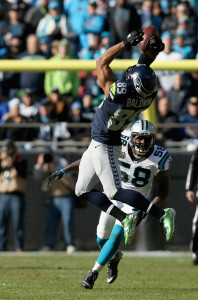
After that terrible first half in the Divisional playoff against Carolina, any hope Seattle had of making that 3rd straight Super Bowl appearance would now depend on them having a 2nd half for the ages. The 31-0 hole they dug for themselves, had the Seahawks come back and won the game, would have been the team’s largest comeback victory in their history;[4] as well as, I believe, the 2nd largest in NFL playoff history.[5] I consider myself to be about as loyal a “Twelve” as there is anywhere, but with those long odds I freely confess that as the Seahawks were lining up to receive the 2nd half kickoff, I thought this game was over.
I was wrong. The Seahawks made a run in the 2nd half of this game very much like the run they made in the 2nd half of the season; and by late in the 4th quarter, as Cam Newton would acknowledge in his post game interview, he and many of the other Panthers players and coaches had very “tight butts” as they watched their “insurmountable” lead dwindle. With nothing to lose, the Hawks were loose and making plays all over the field:
- Seattle’s turnaround started when Tyler Lockett received the 2nd half kickoff, started up field, broke to his left, found an alley and returned the ball to the Seattle 49 yard line to give the Seahawks excellent field position. That field position got better when a Panthers player was flagged for unnecessary roughness and a 15 yard penalty gave Seattle the ball at the Panthers 36 yard line with a first down. With Seattle running their version of the “hurry up” offense Wilson then completed 4 straight passes, the last a 13 yard scoring pass to Jermaine Kearse at the left end zone sideline; a play in which he easily beat Panthers cornerback Robert McClain. Seattle’s mini-drive took all of 1 minute and 33 seconds off the clock and the Hawks had their first 7.
Seattle forced the Panthers to punt on their next possession when Hawks rookie defensive lineman Frank Clark sacked Cam Newton on a 3rd down play. Wilson and co. took over at their own 37 yard line with 10 minutes and 20 seconds to play in the 3rd quarter. On the very first play of this drive Russell Wilson and Doug Baldwin very nearly struck again when Baldwin broke up field from the scrimmage line and executed a double move that left him streaking toward the end zone down the left sideline all by himself. As the receiver executed the 2nd move of his route and broke deep Wilson lofted a perfect spiral toward him that was just a bit too strong, clearing Baldwin’s outstretched hands by about a foot. Had the connection been made it would have been an unbelievable 63 yard touchdown pass; but the Seahawks offense was anything but daunted. On 3rd down from the 37 Wilson scrambled for 14 yards to a first down at the Carolina 49. The Hawks QB then hit Jermaine Kearse on the left sideline for 16 yards to the Carolina 33 and another 1st down. On the next play Carolina sacked Wilson for a loss of 9 yards, which Russell mostly got back on an 8 yard scramble up the middle to set up a 3rd and 11 for Seattle at the Panthers 33. That was when Lockett lightning struck.
- On that 3rd and 11 play from the Carolina 33 Wilson was in the shotgun with running back Christine Michael to his right in the backfield. Three receivers were aligned to the left side of the field; and split to the right, with Panthers All Pro corner Josh Norman set against him in press coverage, was Tyler Lockett. Ordinarily in that situation it is hard to believe that Lockett would be the primary receiver, Norman being the Panthers best defender, but on the snap of the ball Norman abandoned Lockett and took off towards Wilson in an all out blitz. That left Lockett streaking towards the end zone with Panthers safety Curt Coleman coming from over the top to try and cover him. It turned out to be the perfect play call for what the Panthers were trying to do. Michael got just enough of a block on Norman to give Wilson the time. At about the 5 yard line Lockett turned on the jets, beat Coleman to the perfectly thrown ball in the deep right corner of the end zone and hauled it in for a touchdown. With the 3rd quarter not even half over the Hawks had another TD to make the score 31-14.
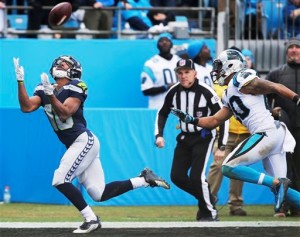
When Lockett scored there were 7 minutes and 40 seconds left in the 3rd quarter. The Panthers took the ensuing kickoff and after getting a couple of first downs Seattle’s D stiffened to force another Carolina punt, giving the Hawks the ball at their own 15 yard line. Three plays gained 8 yards and Seattle lined up for a punt of their own; but instead of kicking the ball employed a bit of chicanery and executed a beautiful fake; the 4th down snap going to the up man Deshawn Shead who broke free around the right side for 17 yards and a Seattle first down. On the next play Wilson hit Jermaine Kearse on a post pattern for 17 more yards to give Seattle another 1st down at the Carolina 43. The Seahawks were rolling, and “Twelves” everywhere had visions of yet another 3rd quarter TD dancing in their heads.
But this time it didn’t happen. If Russell Wilson is not yet an elite quarterback (and I personally believe he is), it is because of plays like the one that was about to take place. A first down Wilson scramble gained nothing leaving Seattle with a 2nd and 10 at the Carolina 43. On the next play Wilson took the snap from the shotgun and retreated to pass. At least 3 receivers were open on this play, Lockett in the flat to Wilson’s left, Baldwin on a deep right to left post pattern over the middle, and Marshawn Lynch on a shallow right to left crossing pattern underneath. If you have recorded this game go back and watch this play again and you will see what I am talking about. None of the Carolina pass rushers broke completely clean and Russell definitely had the time to make a read and a throw. Lynch in particular was wide open on the shallow crossing route, mainly because the man assigned to him, Panthers corner Josh Norman, whether on his own or by design, simply abandoned Lynch and took off on a delayed blitz towards Wilson. For whatever reason Wilson gave up on the play way too early and went into scramble mode, which allowed Norman to corral him 14 yards behind the line of scrimmage; leaving the Seahawks in a 3rd and 24 hole. It was a devastating sack for Seattle, possibly game changing; destroying as it did another promising drive. It is this type of play that, to me, is Russell Wilson’s last significant weakness as a quarterback. At times, and those times are becoming scarcer, he gives up on plays too early, when he doesn’t really have to, and starts to scramble. If he could just hang in there a tick longer there are plays to be made; or at least a throw away to avoid a sack. He’ll get there. Unfortunately, in this game that tendency of his really hurt the Seahawks in my estimation, not just on this play, but on others as well. I’m sure he would tell you the same.
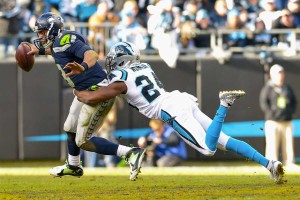
Following that stalled drive Seattle had to punt and the contest moved on into the 4th quarter with Carolina in possession and looking to close out the game. The Seahawks, however, were far from dead. The Panthers managed a couple of first downs and took a few minutes off the clock, but had to punt after KJ Wright and Bruce Irvin threw Newton for a 3 yard loss on a 3rd and 2 play at the Carolina 43 yard line. The Hawks took over following the punt at their own 27 yard line with 9 minutes and 32 seconds left in the game. For Seattle there was no tomorrow. To have any chance of winning at all they needed another touchdown and they needed it quick. On the first play of the possession Wilson tried to hit Jermaine Kearse on a deep corner route to the left side. Kearse was open but once again Wilson’s pass was too strong and the Hawks receiver just couldn’t get to it. The next play, however, gave us all still another taste of the Seahawks future in the form of Tyler Lockett:
- The play started with Wilson in the shotgun and Marshawn Lynch in the backfield to Wilson’s left. Split to the right were Baldwin, Kearse and Lockett (on the outside) in that order. On the snap of the ball Wilson was immediately pressured by Panthers defensive end Jared Allen on the left, so Wilson sprinted to his right away from Allen while looking for a receiver. Well over 20 yards down field he spotted Tyler Lockett, who had driven his defender back by faking a vertical route and then breaking to the sideline. While on a flat out, lateral run the Hawks QB let fly a bullet pass in the direction of the young receiver. The ball arrived in Lockett’s hands just as he was leaning over and outside the sideline while keeping his toes in contact with the ground (barely) inside the sideline. It was an unbelievable catch by Lockett; and an unbelievable throw by Wilson. Johnny Unitas and Raymond Berry[6] could not have done it better. In fact, it was so unbelievable that the ref didn’t believe it either and called the pass incomplete; thus forcing Carroll to throw his challenge flag to get the play reviewed. Replays clearly showed that Lockett definitely got both feet (toes) down in bounds and the official’s call of incomplete was overturned. His incredible catch resulted in a 27 yard gain for the Hawks, who now had a 1st and 10 at the Panthers 46 yard line.
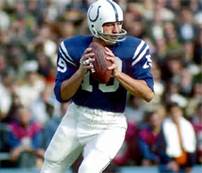
A succession of quick Wilson passes and a Lynch 8 yard run ate up 43 yards and left Seattle with a 3rd and goal situation at the Carolina 3 yard line. The stage was now set for the next miraculous play by Russell Wilson and Jermaine Kearse, who have been making a habit of such plays over the past 3 post seasons:
- For this play Wilson was once again in the shotgun but this time Lynch was in the backfield to Wilson’s right. Split to the right again were Baldwin, Lockett and Kearse; but as Wilson was calling the signals Lockett went into motion crossing behind the center moving from right to left, and wound up split to the left side. Opposite Kearse, who was to the widest right, was Panthers All Pro cornerback Josh Norman in press coverage. On the snap of the ball Wilson’s initial read was to Lockett who was running a shallow slant route across the goal line, but Lockett was well covered. Wilson had no time for a 2nd read because Panthers defensive end Jared Allen again came free up the middle, forcing the Seattle QB first to his right, and then backwards and into one of his patented 360 degree spin moves, and then backwards again to almost the 20 yard line. Meanwhile Kearse drove Norman backwards in to the end zone and, on seeing his quarterback in trouble, managed to use his hands to get behind Norman and momentarily free of him. It was then Wilson spotted him, and while falling backwards with Allen grabbing his legs got off a pass with just enough on it to clear the outstretched arm of Norman at the top of his jump. (Replays showed that Norman’s fingertips actually grazed the ball as it passed over.) Behind Norman, and in perfect position for the end zone catch, was Kearse. All he had to do was jump up and grab the ball, which he easily did, and the Hawks had their 3rd TD of the 2nd half.
The Seattle touchdown made it 31 to 21—a 2 score game with 6 minutes and 4 seconds left to play. Any chance of a Seahawks victory would now hinge on the defense making another stop and getting the ball back to the offense; and doing it fast. It must be commented here that Seattle’s defense played well enough to win this game. Despite all the troubles the unit had in the season’s first half, by season’s end they had returned to form and were playing well. For the 4th consecutive season they led the league in points allowed (17.3 per game) and were number 2 in yards allowed, behind the Denver Broncos. Defensive lineman Michael Bennett and linebacker KJ Wright in particular had stellar seasons, but Earl Thomas, Richard Sherman, Bobby Wagner and Cliff Avril were excellent as well. The reason the Seahawks were able to claw their way back against the Panthers in the 2nd half had more to do with the fact that the Hawks D was able to completely shut down Cam Newton and the Carolina offense than anything else. Had the Panthers been able to mount even one scoring drive in the 2nd half the game would have been out of reach—but against Bennett, Avril and the LOB and co. they couldn’t even get a smell. Carolina’s next 4 possessions after their last TD at the 6 minute mark of the 2nd quarter gained a combined 70 yards; and all 4 ended in punts. The Panthers possession following Seattle’s kickoff with 6 minutes left in the game would be no different. Carolina managed to keep the ball for 5 plays and gained 19 yards while consuming 3 minutes and 15 seconds before they once again had to punt. For the last 36 minutes of playing time in this game, against the team with by far the best record in the league, the Seahawks defense was lights out!
After the Carolina punt Seattle’s possession started at their 22 yard line with 2 minutes and 49 seconds left to play. If the Hawks could just drive for at least a field goal and then get a successful on-side kick, just like last year against the Packers, they would have a shot to tie the game and go into overtime…My head was telling me to not be too hopeful—I mean what are the chances of winning in overtime on successful on-side kicks two years in a row in the playoffs? Those odds have got to be long. But even as I was thinking this Russell Wilson and the Seahawks offense began making play after play to drive down the field:
- On the first play of the drive Wilson hit Doug Baldwin for 13 yards and a first down to the Seattle 35…
- A short pass to Kearse at the right sideline for 8 yards was followed by a Wilson strike to Luke Willson in the left flat which the tight end advanced for 14 yards and another 1st down…2 minutes and 19 seconds left in the game.
- An incompletion on a left deep corner route to Baldwin and a 6 yard completion to Kearse brought the game to the 2 minute warning and left the Hawks with a 3rd and 4 at the Panthers 37.
- A Tyler Lockett false start on 3rd down cost Seattle 5 yards and created a 3rd and 9 situation at the Carolina 42. Wilson then hits Doug Baldwin for 13 yards and another first down to the Panthers 29. The Seahawks are now in Steven Hauschka field goal range.
- Wilson hits Baldwin again, this time for 16 yards to the Carolina 13 yard line, where Seattle has another 1st down. He spikes the ball on the next play to stop the clock.
- Following a delay of game penalty on Seattle Russell Wilson takes two shots into the end zone, first to Kearse and then to Luke Willson—both incomplete. Steven Hauschka comes in the game and kicks a 36 yard field goal to move Seattle to within 1 score of Carolina at 31-24 with 1 minute and 12 seconds left in the game.
Everything now depended on Steven Hauschka and the Seahawks executing another successful on-sides kick. Could the impossible happen again? The Carolina “hands” team was on the field, as was Seattle’s, overbalanced to the kicker’s right, which is obviously where he intended the ball to go…just like last year.
Alas…we all know what happened next. Hauschka’s kick was actually perfect—I don’t think he could have hit it any better. His foot struck high on the ball which drove it into the turf and, in turn, caused it to bounce high and over the first line of Carolina players, identical to last year. This time there would be no Brandon Bostick [7]to misplay the ball, however. It descended directly toward the waiting arms of Panthers linebacker Thomas Davis, who leaped high to grasp it. With 1 minute and 11 seconds left, there was nothing the Seahawks could do. The ball and the game were Carolina’s.
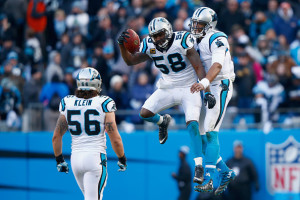
Seattle’s effort for this season and for this game was magnificent; but in the end the holes they dug in both were too great for even this remarkable team to overcome. Too often in this season’s first half Seattle let leads slip away and could not finish games, and the slow start in this Carolina game ultimately did them in. It is so tough to win consistently in the NFL. The rules, the schedules, the draft and the salary cap are all stacked against teams having consistent success. If you have been successful and a Super Bowl champion other teams circle you on their schedule and you always get their best shot. Plus, if you are successful, you end up playing more games, and no team has played more games than the Seahawks over the last 3 seasons.
There are lots of excuses for what happened to the Seahawks this year. But the truth is summed up best, I think, by something Seattle Times and KJR sports radio pro football analyst Hugh Millen wrote in his column a couple days after the Carolina playoff loss. In the article Millen commented:
“Whatever praise is due the Seahawks for nearly coming back from 31-0 is exactly proportional to the criticism they deserve for putting themselves behind 31-0…What applies to Sunday’s NFC divisional playoff game against the Carolina Panthers applies to seasons as well: The finishes have been brilliant, but it’s time to attach more significance to a faster start.”
Amen to that! This is a lesson the Seahawks need to learn, and I think and hope that they will. If they do, with young and budding stars like Tyler Lockett and Thomas Rawls; and the veteran, core players and elite quarterback they have, I think we “Twelves” have more championships and Super Bowls to look forward to.
I can’t wait for next season!
Go Hawks!!
Copyright © 2016
By Mark Arnold
All Rights Reserved
[1] “Sudden Change” – when a team’s offense or special teams turn the ball over to the opposing team to put their defense back on the field — as coaches refer to it.
[2] Unfortunately the Seahawks lost Thomas Rawls for the season when he broke his ankle in the Ravens game, but by then it was obvious that in the undrafted, rookie free agent Seattle had found Beastmode’s likely replacement whenever he retires or the team decides to release him. By any measure Rawls had a superb rookie season, rushing for over 800 yards (5.6 yards per carry) and 4 TDs.
[3] The Seahawks also hit pay dirt in 2015 with 2nd round draft pick Tyler Lockett who caught 51 balls for over 600 yards and 6TDs, plus a punt return TD and a kick return TD. The speedy Lockett looks to have the potential to become a great NFL receiver in the mold of Pittsburgh’s Antonio Brown.
[4] Seattle’s largest comeback victory to this point in their history took place on 3 November, 2013 during their Super Bowl Championship season when they came from 21 down to defeat the Tampa Bay Buccaneeers. For the story of that game please go to http://fromanativeson.com/2013/11/04/seahawks-come-from-21-down-to-beat-bucs-in-ot-thriller-by-mark-arnold/ at fromanativeson.com.
[5] The largest comeback in NFL playoff history took place on January3rd, 1993 when the Buffalo Bills came back from a 32 point deficit to defeat the Warren Moon led Houston Oilers in overtime 41-38. The comeback was led by Buffalo backup quarterback Frank Reich who took over for regular quarterback Jim Kelly after he hurt his knee.
[6] Hall of Famers who both played for the Baltimore Colts in the late 1950’s and across the 1960’s, Johnny Unitas and Raymond Berry were one of the great quarterback/receiver combos of all time. Unitas was the prototypical drop back, pocket passer and Berry the sure-handed, precision route runner. Among other innovations, between them they developed and made famous the sideline, toe tapping route that we saw used by Russell Wilson and Tyler Lockett vs. the Panthers.
[7] In case you have forgotten, which I think no Hawks fan could do, Brandon Bostick was the Green Bay tight end who misplayed the Seattle on-sides kick with 2 minutes and 9 seconds to go in last year’s NFC Championship game. Seattle’s Chris Mathews recovered the deflection which allowed the Seahawks to take their first lead in a game they had trailed by double digits in nearly all day. Seattle ultimately won the game in overtime to advance to the Super Bowl for a 2nd straight season.

